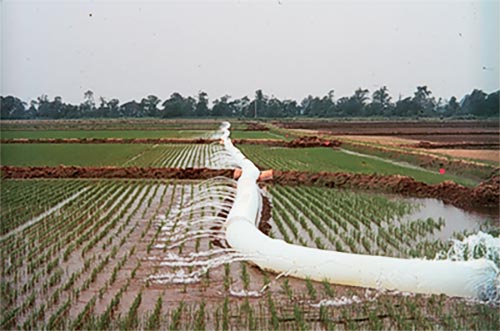
Side inlet rice irrigation conserves water and improves production management.
Side inlet irrigation systems deliver water to each bay of a rice field at the same time. This is usually accomplished by placing above-ground irrigation pipe along the side of the field with inlets into each bay. By comparison, a conventional "cascade" irrigation system has a single water inlet at the upper end of the field. Each bay is filled to capacity before water cascades into an adjacent bay.
Side inlet rice irrigation provides greater control of water and is easier to manage. The benefits of the side inlet system include water conservation, lower energy cost and reduced cold water damage to rice. Because the whole field is flooded in a more timely and uniform manner, weed control and nitrogen fertilizer retention are much improved. Nutrient and chemical loss are also reduced because of less runoff exiting fields.
Methods
A rice irrigation demonstration was established near Morehouse, Missouri with Jennings Brothers Farms, Inc.1 to compare water use between traditional cascade and side inlet irrigation systems. Each side inlet system was designed using the U.S. Department of Agriculture (USDA)2 Natural Resources Conservation Service Side Inlet Irrigation Computer Programs.
Two large-scale side inlet fields (25 acres and 46 acres) were compared with one cascade field (39 acres). Irrigation flow instruments and electric meters were used to monitor irrigation events. Both methods were utilized on the cascade system. These data were then compared to electric meter readings on Side Inlet Field A and flow meter readings on Side Inlet Field B. Onset of initial flooding was within one day for each field. No levee gates were installed in Side Inlet Field B. Thus, water distribution was solely dependent upon the pipe design.
Results
Irrigation requirements for both of the side inlet fields were substantially less than the cascade field. Because gate settings in side inlet fields are maintained above the desired flood level, rainfall can be collected during the growing season. In 1998, the cooperators reported 8 inches of rain at the demonstration site.
Electric meter readings from Side Inlet Field A indicate that 39% less energy was required for irrigation. Flow meter readings on Side Inlet Field B, where the water holding capacity of the soil was superior to Field A, indicate that 60% less irrigation was required.
Conclusions
Each side inlet system in this demonstration required less irrigation application for rice. Although the demonstration was not a replicated experiment, numerous observations over the last several seasons have convinced us that the side inlet system saves substantial water. Savings in application rates have consistently ranged between 30–50%.
For further information about side inlet or for design assistance contact any USDA-Natural Resources Conservation Service (NRCS) office in southeast Missouri. This service is free of charge.
Written by Steven Hefner, USDA-NRCS resource conservationist; John Hester, USDA-NRCS irrigation management engineer; and Clayton Robertson, USDA-NRCS resource conservationist
The side inlet demonstration was partially funded by Region VII, U.S. EPA, through the Missouri Department of Natural Resources, under Section 319 of the Clean Water Act. This grant is administered by the Bootheel Resource Conservation and Development Council Inc.
1The USDA-NRCS Irrigation & Water Quality Office staff would like to express their gratitude to the cooperators, Tom and Dan Jennings.
2The U.S. Department of Agriculture (USDA) prohibits discrimination in all its programs and activities on the basis of race, color, national origin, gender, religion, age, disability, political beliefs, sexual orientation, and marital or family status. (Not all prohibited bases apply to all programs.) Persons with disabilities who require alternative means for communication of program information (braille, large print, audiotape, etc) should contact USDA's TARGET Center at 202-720-2600 (Voice and TDD). To file a complaint of discrimination, write USDA, Director, Office of Civil Rights, Room 326W, Whitten Building, 14th & Independence Avenue, SW, Washington DC 20250-9410 or call (202) 720-5964 (Voice or TDD). USDA is an equal opportunity provider and employer.